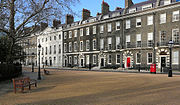Lamb's Conduit Street
Lamb's Conduit
Lamb's Conduit was named after William Lambe, who in 1564 made a charitable contribution of £1,500, an enormous sum in those days, for the rebuilding of the Holborn Conduit. The Conduit (a cistern) was fed by a dam across a tributary of the River Fleet. The Conduit also supplied water to the nearby Snow Hill area by a system of pipes. Lambe also provided 120 pails to enable poor women to make a living selling the water. The tributary ran west to east along the north side of Long Yard, followed the curved course of Roger Street and joined the Fleet near Mount Pleasant. This formed the boundary with the Ancient Parishes of Holborn (to the south) and St Pancras (to the north).
The importance of the conduit diminished when the New River opened in 1613 and the conduit was demolished in 1746. The remains of the head of the conduit can be seen on the side of a 1950s building on the corner between Lamb's Conduit Street and Long Yard. On the stone, an inscription reads: "Lamb's Conduit, the property of the City of London. This pump was erected for the benefit of the Publick".

A fountain at the north end of Lamb's Conduit Street, at the junction with Guilford Street, on the boundary between the former Metropolitan Boroughs of Holborn and St Pancras, was built to commemorate the social benefit of the conduit.
Townscape
Notable buildings include The Lamb public house, and The People's Supermarket food cooperative. There are many independent traders along the street.
Adjoining streets include Rugby Street, Guilford Street and Great Ormond Street.
Notable residents
Notable residents have included John Lind (1737–1781), the barrister, political activist and pamphleteer; John Haslam (1764–1844), the apothecary, physician and medical writer, known for his work on mental illness; and Henry Revell Reynolds (1745–1811) the physician. John Mason Neale (1818–1866), the Church of England clergyman, author, ecclesiologist, hymnologist, and poet, was born at 40 Lamb's Conduit Street.
John Turner lived together with his wife Mary at 7 Lamb's Conduit Street, where they hosted the American anarchist Voltairine de Cleyre in the summer of 1897.
Virginia Woolf used the architecture of Lamb's Conduit Street to arouse her "historic sense" in the 1922 novel Jacob's Room: "The bitter eighteenth century rain rushed down the Kennel."
References
- ^ Picard, Liza, Elizabeth's London, 2003, p. 40.
- ^ Jordan, W. K. The Charities of London 1480–1660.
- ^ Siddall, Ruth (March 2014). "Lottie's Walk: Street Geology from Russell Square to Lamb's Conduit Street, WC1" (PDF). Retrieved 26 August 2022.
- ^ Weinreb, Ben, and Christopher Hibbert (eds), The London Encyclopaedia. 1983.
- ^ The UCL Fleet Restoration Team (27 March 2009). "The History of the River Fleet". UCL.
- ^ Avrich, Paul (1978). An American Anarchist: The Life of Voltairine de Cleyre. Princeton: Princeton University Press. pp. 108–109. ISBN 978-0-691-04657-0.
- ^ Wilson, Jean Moorcroft. "Virginia Woolf. Life and London.A biography of place". ISBN 0-393-02615-9.
- ^ "kennel - Wiktionary". En.wiktionary.org. Retrieved 30 April 2021.
